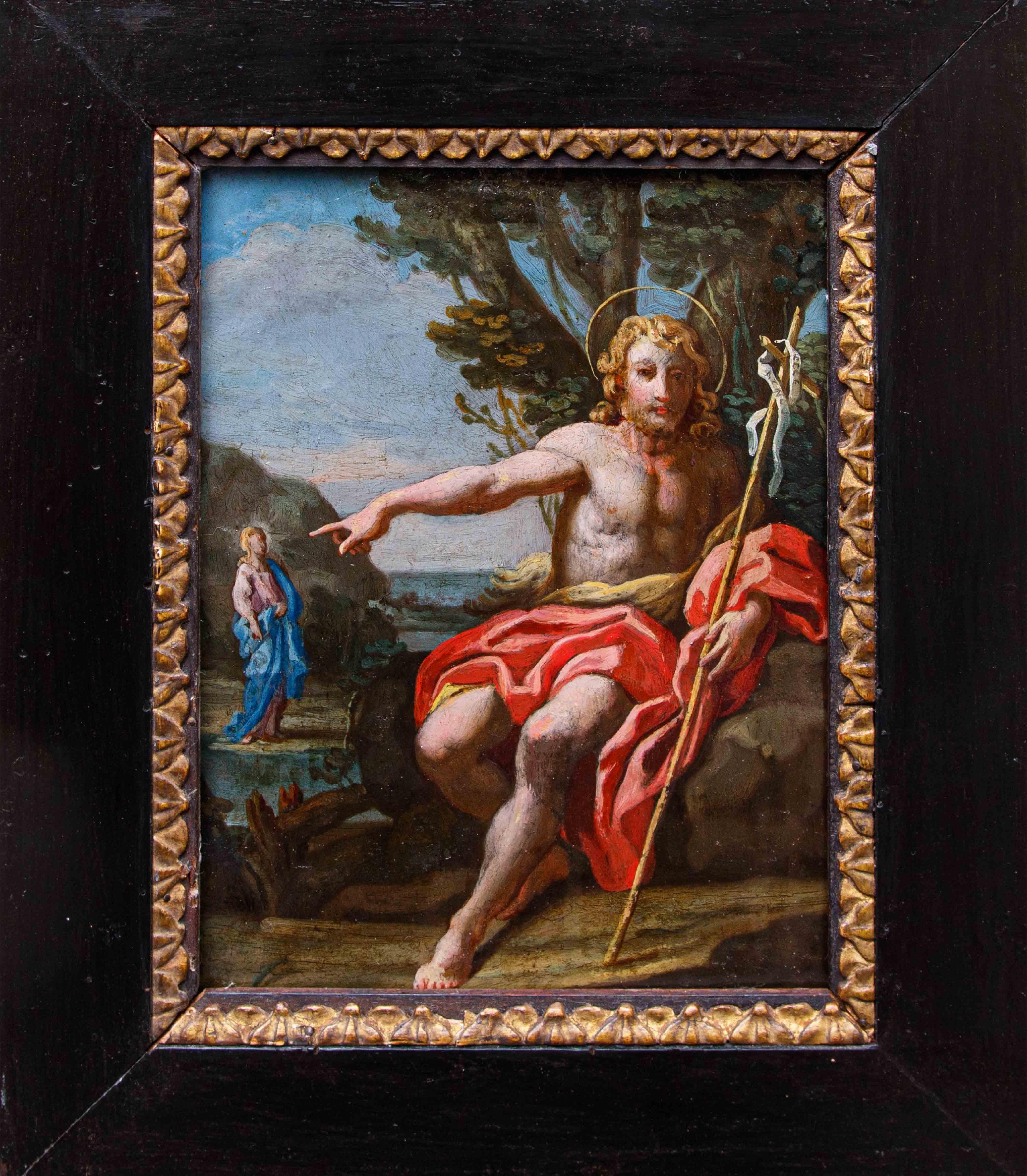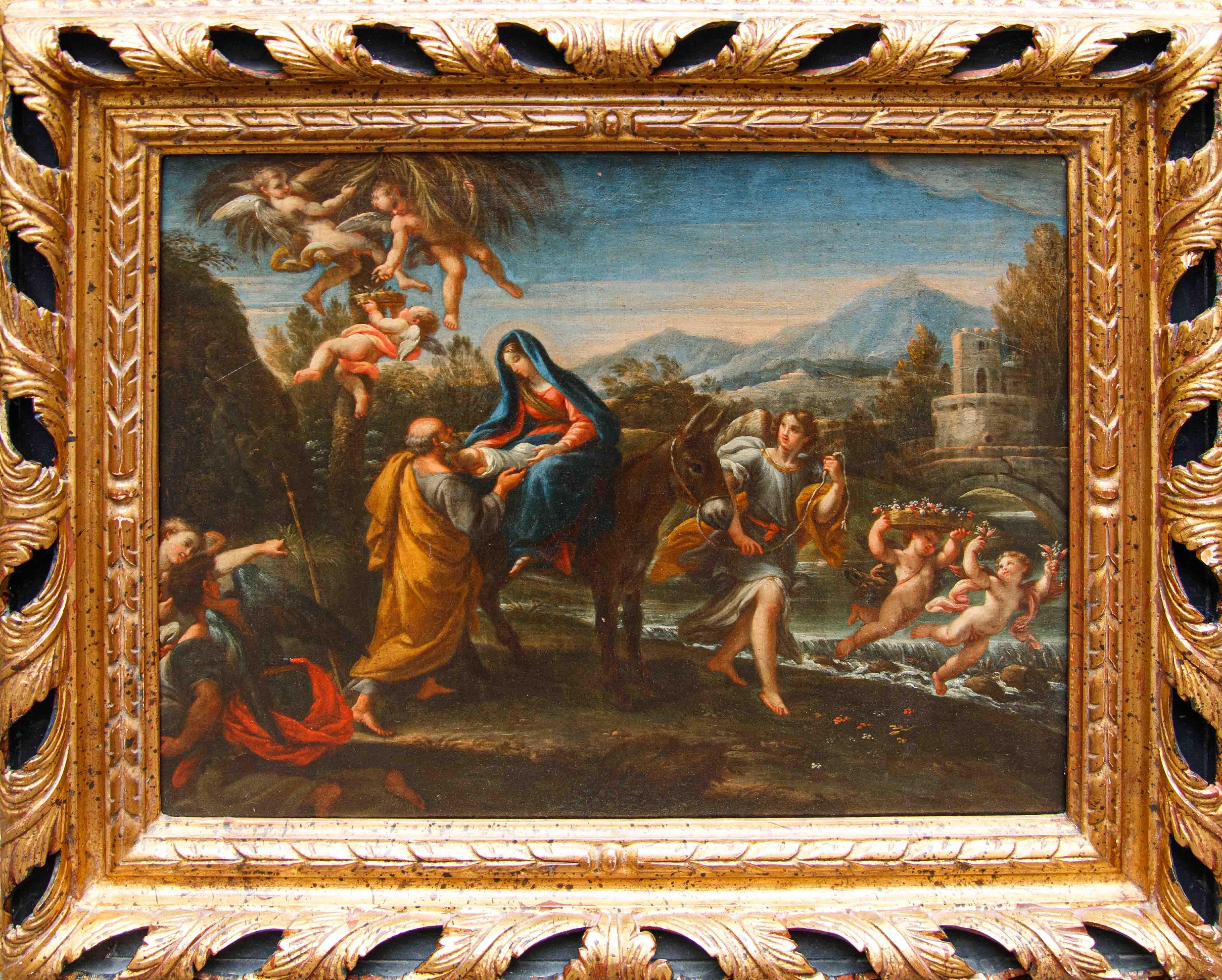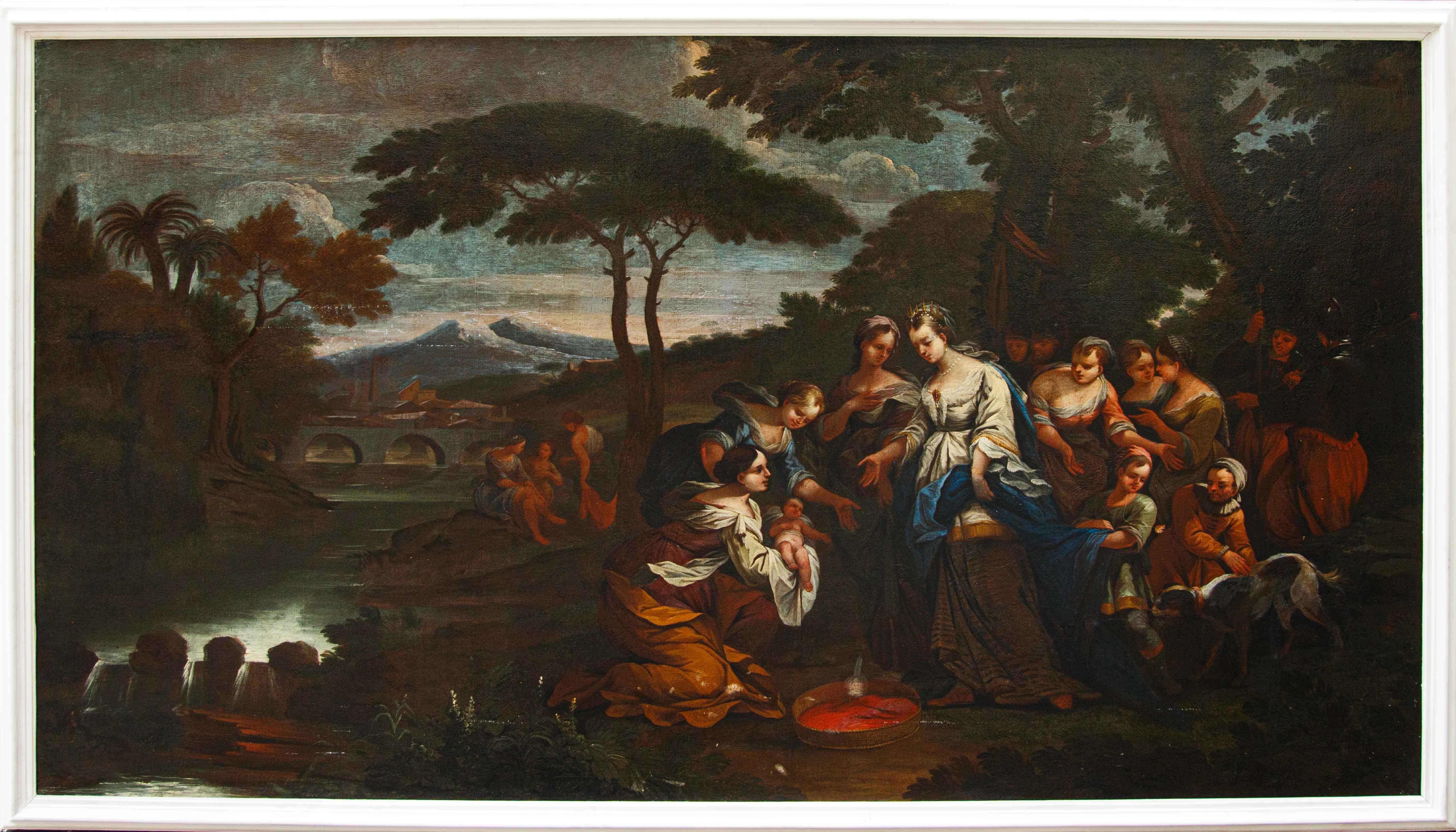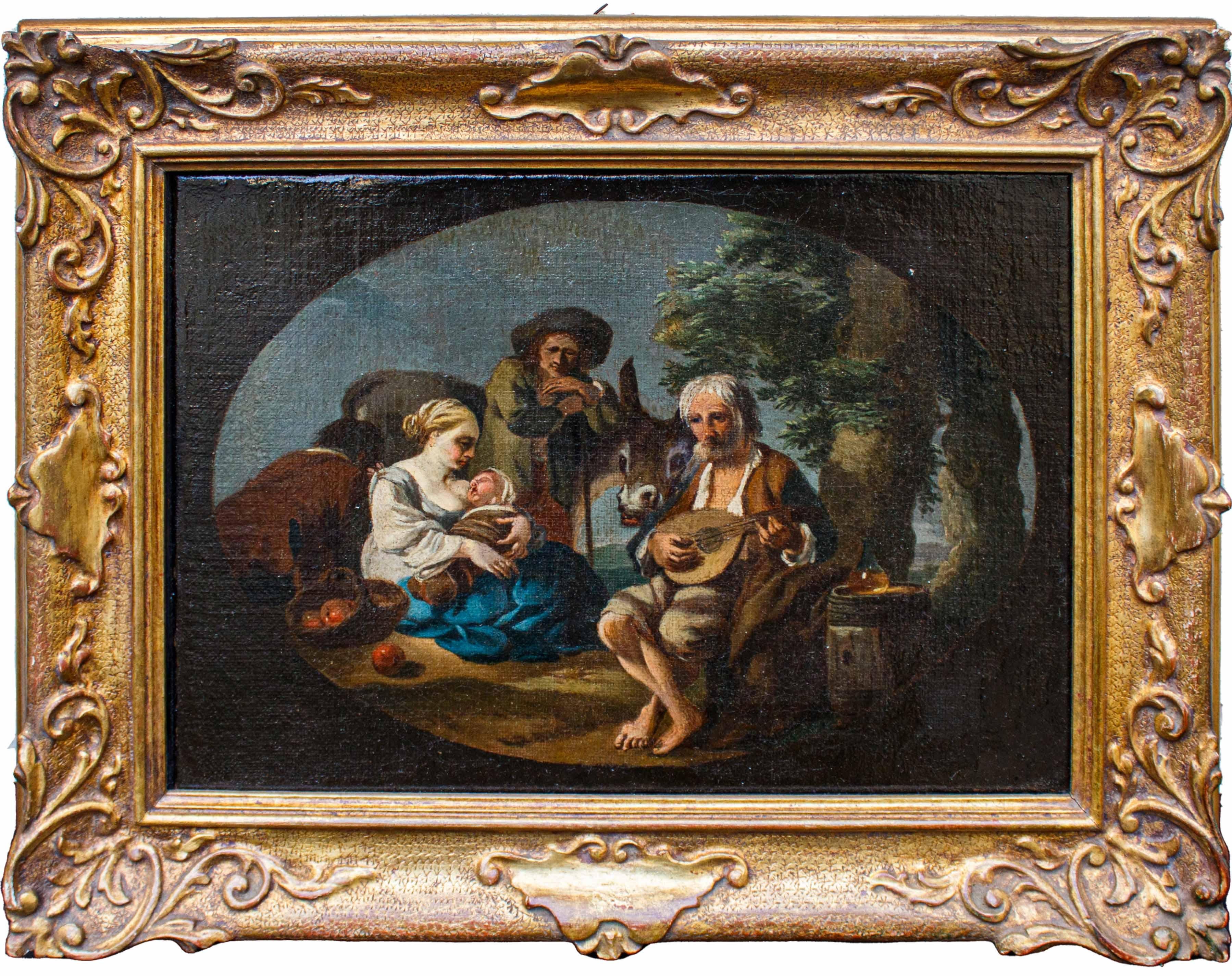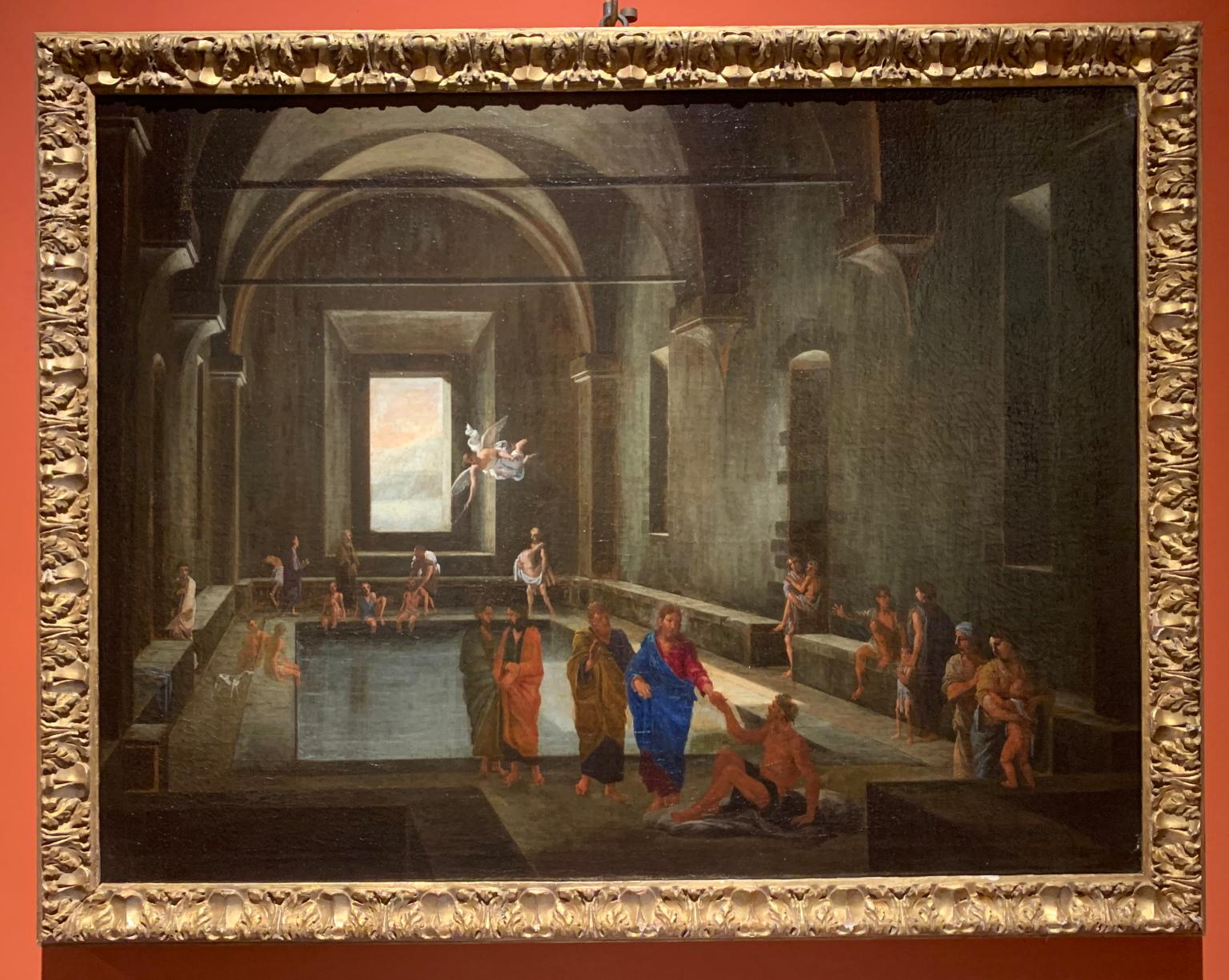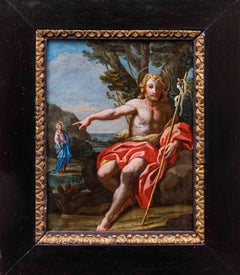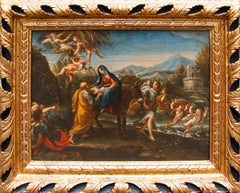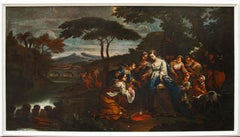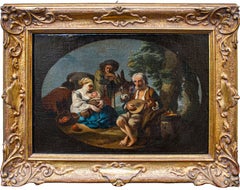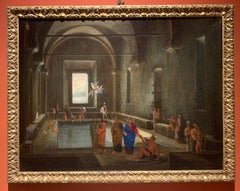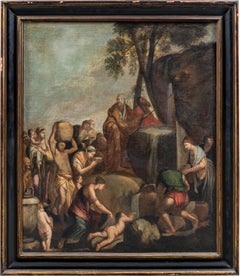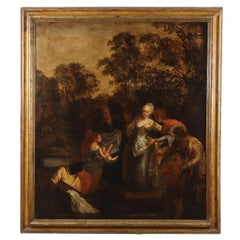Items Similar to 17th century, Bottega of Giovanni Francesco Romanelli, The Idolatry of Solomon
Want more images or videos?
Request additional images or videos from the seller
1 of 13
Giovanni Francesco Romanelli17th century, Bottega of Giovanni Francesco Romanelli, The Idolatry of SolomonXVII Century
XVII Century
$5,150.28
£3,816.64
€4,300
CA$7,031.11
A$7,821.82
CHF 4,100.30
MX$95,580.79
NOK 52,212.19
SEK 49,150.55
DKK 32,739.82
Shipping
Retrieving quote...The 1stDibs Promise:
Authenticity Guarantee,
Money-Back Guarantee,
24-Hour Cancellation
About the Item
17th century, Roman School
Workshop of Giovanni Francesco Romanelli, known as the Viterbese (Viterbo, c. 1610 -1662)
Solomon's idolatry
Oil on canvas, 73.5 x 59.5 cm
The painting is not signed
The biblical episode of Solomon worshipping idols is one of the saddest and most surprising passages of scripture, narrated in the First Book of Kings, chapter 11. Solomon, the king famous for his wisdom and for building the magnificent Temple in Jerusalem dedicated to God, falls into an apostasy that stains his reputation and leads to grave consequences for the kingdom of Israel. Solomon's problem began with his many foreign wives. Despite the fact that God's Law had forbidden the Israelites to marry women from pagan peoples lest their hearts stray from the Lord, Solomon took as many as seven hundred princesses and three hundred concubines from Moab, Ammon, Edom, Sidon, and Hittite. These women, for the most part, came from cultures that worshiped deities other than the God of Israel. As he grew older, and under the influence of his wives, Solomon's heart began to deviate. They urged him to follow their deities, and so Solomon, who had shown deep devotion in his youth, ended up worshiping abominable idols. Among the deities Solomon began to worship were Astarte, the goddess of the Sidonians; Milcom, the deity of the Ammonites; Chemos, the abomination of the Moabites; and Moloc, the idol to which human sacrifices were offered.
To please his wives, Solomon not only tolerated idolatry, but went so far as to build "high places"-that is, pagan shrines-on a mountain opposite Jerusalem, dedicated to these foreign deities. In these places, his women offered incense and sacrifices to their gods, and Solomon himself participated in these practices, departing from the covenant he had made with the Lord. Solomon's apostasy was a grave affront to God, who had manifested himself to him twice, giving him specific orders not to follow other gods. Divine indignation was not long in coming. The Lord announced to Solomon that, because of his disobedience and departure from the covenant, he would take the kingdom from him. However, out of love for David, his father, and out of love for Jerusalem, God's chosen city, this punishment would not take place during Solomon's lifetime, but would be realized during the reign of his son, to whom only one tribe would be left. The episode of Solomon worshiping idols serves as a biblical warning about human vulnerability to temptation, even for those who have been endowed with great wisdom and divine blessings. It shows how pride, luxury and spiritual compromises can lead even the greatest to fall, and how personal choices have consequences that affect entire generations and the fate of a nation.
The painting, with its agile and loose pictorial draftsmanship, pastel hues and fluid brushstrokes, presents several features that associate it with the production of the seventeenth-century Roman school, and, in particular with the work of members of the Cortonesque circle: in fact, the work analyzed here has several similarities, both thematically and in terms of the technical-executive dimension, with a painting by the Pistoiese artist active mainly in the Roman sphere, Lazzaro Baldi (Pistoia, c. 1624 - Rome, 1703), The Idolatry of Solomon, mentioned, among others, by Father Sebastiano Resta and currently part of the collections of the Spada Gallery (inv. 274). On a technical-executive level, our painting shows clear similarities with the pictorial production of another artist of Pietro da Cortona's circle, Giovanni Francesco Romanelli, known as the Viterbese or Raffaellino (Viterbo, c. 1610- Viterbo, 1662). Romanelli was one of the leading figures of seventeenth-century Rome, a pupil of Pietro da Cortona and a key figure in the transition between the more exuberant Baroque phase and a more classicist expression. His style, while rooted in the prolific tradition of the Roman Baroque, is distinguished by certain peculiarities that make it recognizable: the interpretation in terms of greater classicism of the doctrine of Pietro da Cortona, the characterization, in terms of particular grace and delicacy, of the female figures in the compositions, the marked legibility of the elected episodes, and a reference to French culture, linked to his stay in Paris. Giovanni Francesco Romanelli's style can thus be described as classicizing Baroque, characterized by elegance, grace, clear compositions, and a refined mastery of color. His works are a bridge between the exuberance of the early Roman Baroque and the more restrained and classicist tendencies that would influence the 18th century.
- Creator:Giovanni Francesco Romanelli (1610 - 1662)
- Creation Year:XVII Century
- Dimensions:Height: 28.75 in (73 cm)Width: 23.23 in (59 cm)
- More Editions & Sizes:73x59Price: $5,150
- Medium:
- Period:
- Condition:
- Gallery Location:Milan, IT
- Reference Number:1stDibs: LU2639216523642
About the Seller
No Reviews Yet
Vetted Professional Seller
Every seller passes strict standards for authenticity and reliability
1stDibs seller since 2023
Typical response time: <1 hour
- ShippingRetrieving quote...Shipping from: Milan, Italy
- Return Policy
Authenticity Guarantee
In the unlikely event there’s an issue with an item’s authenticity, contact us within 1 year for a full refund. DetailsMoney-Back Guarantee
If your item is not as described, is damaged in transit, or does not arrive, contact us within 7 days for a full refund. Details24-Hour Cancellation
You have a 24-hour grace period in which to reconsider your purchase, with no questions asked.Vetted Professional Sellers
Our world-class sellers must adhere to strict standards for service and quality, maintaining the integrity of our listings.Price-Match Guarantee
If you find that a seller listed the same item for a lower price elsewhere, we’ll match it.Trusted Global Delivery
Our best-in-class carrier network provides specialized shipping options worldwide, including custom delivery.More From This Seller
View All17th century, School of the Carracci, St. John the Baptist
By Annibale Carracci
Located in Milan, IT
17th century, school of the Carracci
St. John the Baptist announcing the coming of Christ
Oil on copper, 24 x 19 cm
Framed, 33 x 26 cm
The painting features in the foreground the...
Category
17th Century Other Art Style Landscape Paintings
Materials
Canvas
Stefano Pozzi (Rome, 1699 - 1768), attr., Rest from the Flight into Egypt
Located in Milan, IT
Stefano Pozzi (Rome, 1699 - 1768), attr.
Rest from the flight to Egypt
Oil on canvas, 49 x 63.5 cm
Framed, 69 x 85 cm
Category
18th Century Other Art Style Figurative Paintings
Materials
Canvas, Oil
Pietro Dandini (Florence, April 12, 1646 - November 26, 1712), The Finding
By Pier (Pietro) Dandini
Located in Milan, IT
Pietro Dandini (Florence, April 12, 1646 - November 26, 1712), attr.
The Finding of Moses
Oil on canvas, 105 x 206 cm
Framed, 116 x 219 cm
Born, as the erudite Baldinucci reports...
Category
17th Century Other Art Style Figurative Paintings
Materials
Canvas, Oil
Paolo Monaldi (Rome, 1710 - after 1779), attr. , Genre scene
Located in Milan, IT
Paolo Monaldi (Rome, 1710 - after 1779), attr.
Genre scene
Oil on canvas, 28 x 38 cm
Framed, 36.5 x 46 cm
The canvas depicts a moment of repose drawn from the rural world: the...
Category
18th Century and Earlier Other Art Style Figurative Paintings
Materials
Canvas, Oil
Girolamo Maria Pesci (Rome, 1679 - 1759), The judgment of Paris
Located in Milan, IT
Girolamo Maria Pesci (Rome, 1679 - 1759)
The judgment of Paris
c. 1705-1710
Oil on canvas, 47 x 36.5 cm
Girolamo Maria Pesci (Rome, 1679 - 1759), a figure distinguished for his e...
Category
18th Century and Earlier Other Art Style Figurative Paintings
Materials
Canvas, Oil
Paolo De Matteis (Piano Vetrale 1662 - Naples 1728), attr., Dream of Joseph
By Paolo de Matteis
Located in Milan, IT
Paolo De Matteis (Piano Vetrale 1662 - Naples 1728), attr.
Joseph's Dream
Oil on canvas, 49 x 65 cm
Antique Roman frame known as "Maratta," of carved and gilded wood, 61 x 76 cm
...
Category
18th Century Other Art Style Figurative Paintings
Materials
Canvas, Oil
You May Also Like
Painting The Preaching of St. John the Baptist, 17th-18th century
Located in Milan, IT
Oil on Canvas. North Italian school of the 17th-18th centuries.
The large scene is filled with figures in ancient Eastern garb, set in a northern, richly vegetated landscape with mou...
Category
Late 17th Century Other Art Style Figurative Paintings
Materials
Oil
Italian Baroque religious figurative painting of the 17th century oil on canvas
Located in Florence, IT
Painted with gilt wood frame, 58 x 75 cm.
is the work of the painter couple Viviano Codazzi (Valsassina 1603-Rome 1670), who specialized as a quadraturist and landscape painter, and...
Category
1640s Baroque Interior Paintings
Materials
Canvas, Oil
Giulio Carpioni workshop (Venetian) - 17th century figure painting - Moses
By Giulio Carpioni
Located in Varmo, IT
Giulio Carpioni (Venice 1613 - Vicenza 1678) workshop of - Moses makes water flow from the rocks.
82 x 68 cm without frame, 97 x 83 cm with frame.
Oil on canvas, in wooden frame (n...
Category
Early 17th Century Baroque Landscape Paintings
Materials
Canvas, Oil
Painting Moses Saved from the Waters 18th century
Located in Milan, IT
Oil on Canvas.
The painting looks to the similar work by Paolo Veronese (1528-1588), dated around 1560-70 and now in the Prado Museum, from which our painting takes up the compositio...
Category
18th Century Other Art Style Figurative Paintings
Materials
Oil
Mythological figurative painting of 19th century Italian Romanticism
Located in Florence, IT
The painting depicts "Ossian tells Malvina about the exploits of his son Oscar" and is dated at lower right "Filippo Bellati did the year 1811" and the unframed measurements are 233 ...
Category
1810s Romantic Figurative Paintings
Materials
Canvas, Oil
Painting with a Healing Scene 17th Century
Located in Milan, IT
Oil on copper. Flemish school of the seventeenth century.
The painting, attributed by oral tradition to Frans Francken the younger (1581 -1642), depicts a miraculous healing perform...
Category
17th Century Other Art Style Figurative Paintings
Materials
Oil
